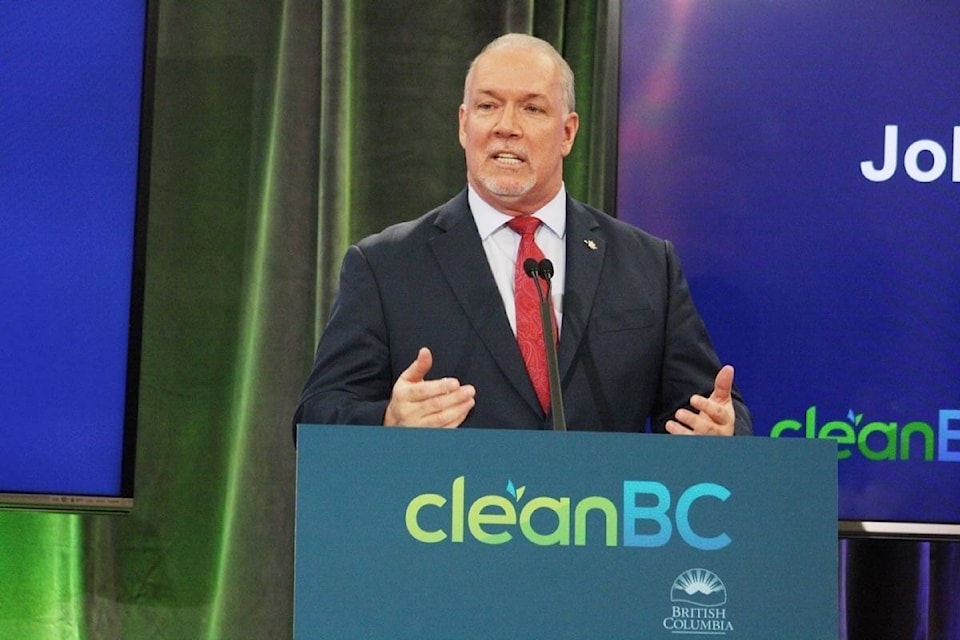The NDP government revealed a slew of transportation, building and jobs measures on Wednesday as part of its wide-scale effort to reduce greenhouse gases by 60 per cent by 2040.
Dubbed CleanBC, the plan lays out how the province will transition from fossil fuels to a “low-carbon economy,” though the public will have to wait on how much it will cost.
“The challenges of climate change are clearly global,” Premier John Horgan told a packed room at Vancouver Public Library’s central branch.
“But the impact is being observed and felt right here… in our forests, in our rural communities where we are facing floods and droughts within months of each other.”
The plan centres on cutting fossil fuel use by 20 per cent and boosting green energy use by 60 per cent by 2050.
Horgan said the move will require an additional 4,000 gigawatt hours of electricity, or an eight-per-cent increase, over current BC Hydro projections. Currently, the province gets two-thirds of its energy from fossil fuels.
That will put the province on track to meet Canada’s commitment to keep global average temperature increases to 1.5 degrees Celsius by 2050, or well below two per cent above pre-industrial levels.
Building on an earlier promise that every car sold in B.C. will be zero-emission by 2040, Horgan said the government will bring down the price of electric vehicles and work with private industry to build more charging stations and train more mechanics to work on them.
The province’s goals will require a 200-per-cent increase in electric car sales by 2030.
The government also promised to lower carbon intensity in fuels by 20 per cent by 2030 and to enhance tailpipe emission standards for cars sold after 2025.
It will also make B.C.’s Building Code more efficient and require buildings to get 15 per cent of their energy from renewable natural gas.
READ MORE: B.C. sets new greenhouse gas reduction targets
Meanwhile, industry will have to make sure 15 per cent of its gas usage is from renewable sources by 2030. Currently, large-scale industry pays about one-third of the carbon tax collected by the province. The government will create a fund from the proceeds to be funnelled back into green incentives.
The plan also targets waste, aiming for 95 per cent of B.C. communities to divert garbage from the landfill, as well as capture and reuse 75 per cent of landfill gas by 2030.
‘Sign of hope’
Environmentalists praised the requirement for the government to project and report on pollution cuts every year, as well as the creation of an independent oversight group.
“It’s taken almost a year, but the Green-supported NDP government has started to head in the right direction,” said the Wilderness Committee’s Peter McCartney. “There’s still much work to do, but this plan is a good start.”
The B.C. director for the Canadian Taxpayers Federation, however, slammed the NDP for reaching high without providing details.
“I really think this this would be better if they rolled this out in shorter pieces, always with costing attached,” Kris Sims said. “I don’t care who you vote for, but you need to know how much this is going to cost you.”
Instead of regulating natural gas use and car emissions, she said the province should scrap the carbon tax and let the market innovate its way to a climate change solution.
What will it cost?
Horgan repeatedly deflected questions from reporters on how much the plan would cost to Finance Minister Carol James and stuck to talking points.
He did say he’d look to Ottawa for help, as well as speak with other premiers at the First Ministers’ meeting in Montreal on Friday.
Said Environment and Climate Change Strategy Minister George Heyman: “We’ve been through this with the finance minister and the details will be in the budget in the spring. Our plan will be fully funded.”



